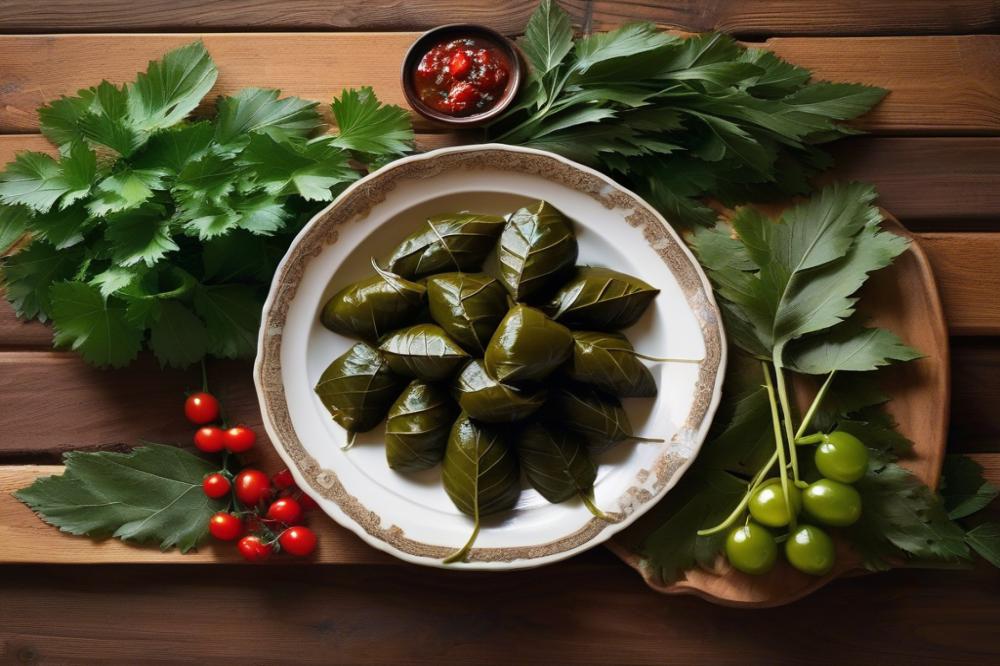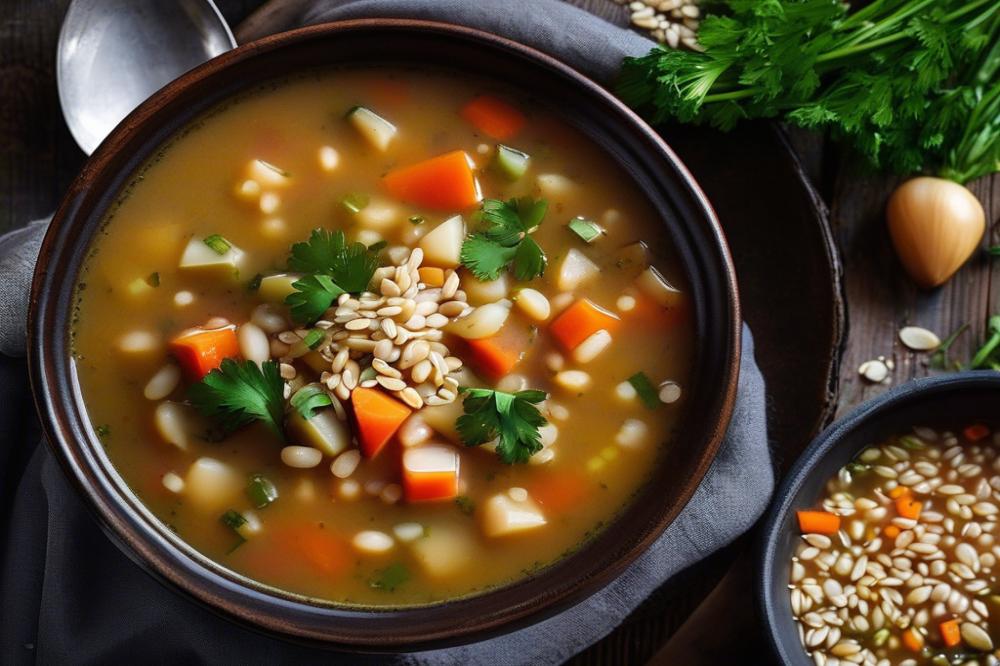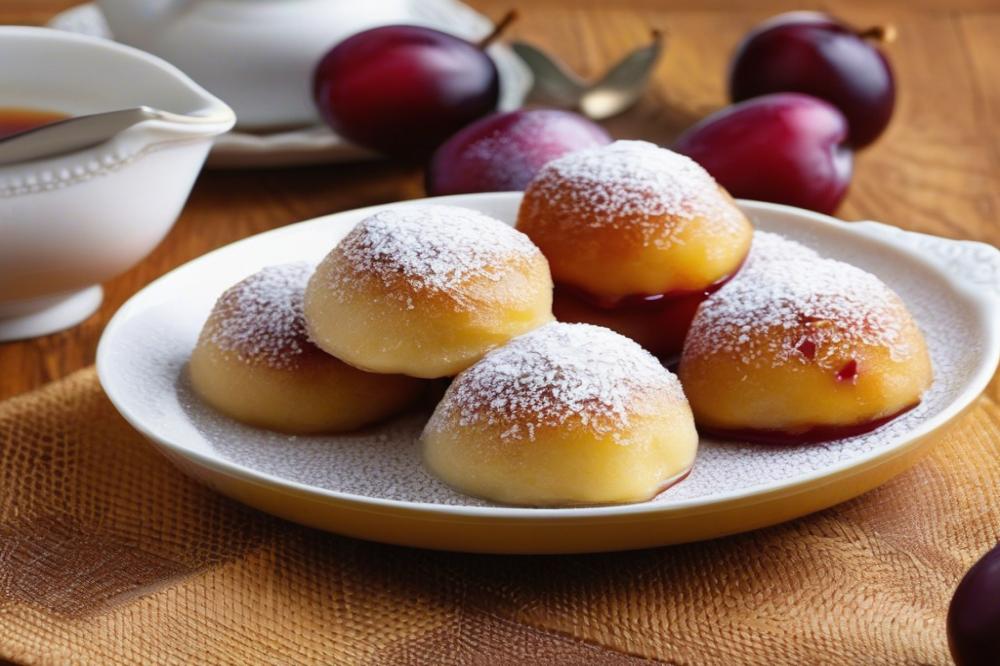Introduction
Dolmades are a classic dish that holds a special place in Greek cuisine. These flavorful Stuffed Vine Leaves showcase the rich heritage of Mediterranean cooking. Often, grape leaves wrap a delightful rice filling seasoned with fresh herbs, making every bite a burst of taste. This cultural dish is not just about food; it reflects the traditions and history of Greece.
The significance of Dolmades goes beyond their delicious flavors. For generations, families have gathered to prepare and share this meal. It symbolizes togetherness and love, values deeply rooted in Greek hospitality. Whether served at a large celebration or a simple family dinner, Stuffed Vine Leaves create memorable moments around the table.
Many people appreciate the versatility of dolmades. They can serve as an excellent vegetarian dish, appealing to various diets. The combination of rice, olive oil, and lemon juice, along with an array of fragrant herbs, offers a nutritious option without sacrificing flavor. A cooking recipe for dolma can be adapted easily, allowing home chefs to personalize this traditional dish according to their preferences.
In essence, dolmades embody the heart and spirit of Mediterranean cuisine. They invite everyone to enjoy a delicious meal, rich in culture and history, while also embracing dietary choices. Experience their unique taste and take part in a culinary tradition that has delighted generations.
Ingredients List and Measurements
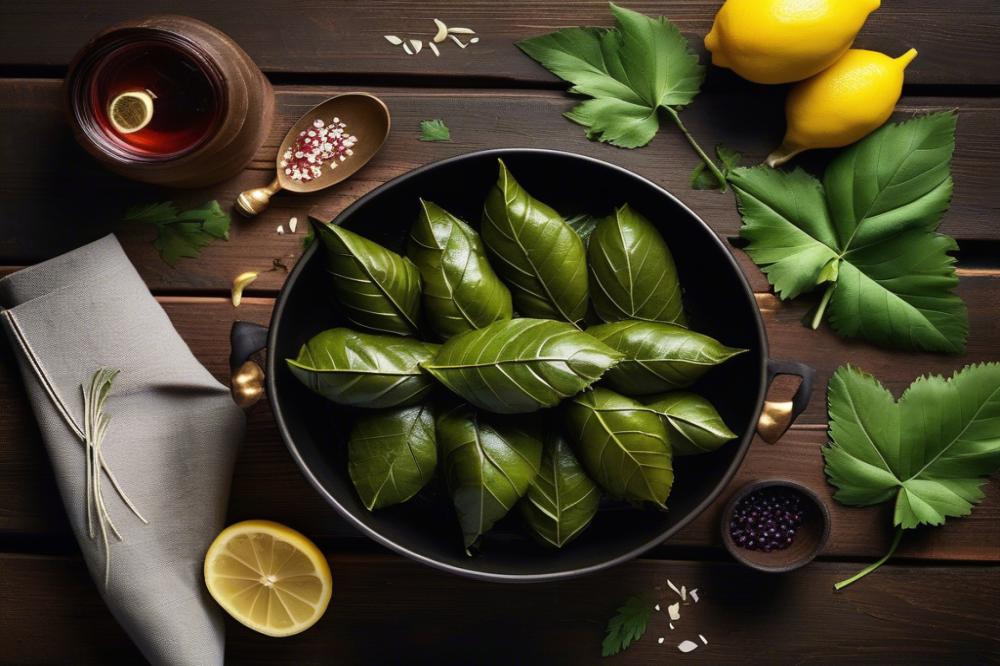
To create velvety dolmades stuffed with rice filling, you’ll need a variety of ingredients. Below is a detailed list to help guide you through the cooking recipe for this fantastic Mediterranean cuisine dish.
- 1 jar of grape leaves (approximately 50 leaves)
- 1 cup of rice (short grain preferable)
- ½ cup of finely chopped onion
- ¼ cup of olive oil
- 1 teaspoon of salt
- ½ teaspoon of black pepper
- 2 tablespoons of fresh dill (or 1 tablespoon dried)
- 2 tablespoons of fresh parsley (or 1 tablespoon dried)
- 2 tablespoons of pine nuts (optional)
- 1 lemon (for juice and zest)
- 1 cup of vegetable broth or water (for cooking)
- 1 teaspoon of cinnamon (optional)
Now, let’s break down the nutritional information for each component:
- Grape leaves: Around 14 calories, 0.2g fat, 2.3g carbohydrates, 1g protein per 10 leaves.
- Rice: Approximately 205 calories, 0.4g fat, 44.5g carbohydrates, 4.3g protein per cup.
- Onion: About 46 calories, 0.1g fat, 10.2g carbohydrates, 1.3g protein per half cup.
- Olive oil: Around 477 calories, 54g fat, 0g carbohydrates, 0g protein per quarter cup.
- Salt: Minimal caloric value, provides no macronutrients but enhances flavor.
- Black pepper: Roughly 6 calories, 0.2g fat, 1.4g carbohydrates, 0.2g protein per half teaspoon.
- Dill: Approximately 5 calories (fresh), negligible fats and carbohydrates.
- Parsley: About 5 calories (fresh), low in fats and carbohydrates.
- Pine nuts: Around 191 calories, 19g fat, 4g carbohydrates, 4g protein per 2 tablespoons.
- Lemon: Approximately 17 calories, 0.2g fat, 5.4g carbohydrates, 0.6g protein per lemon.
- Vegetable broth or water: Low in calories with negligible nutritional content when using water.
- Cinnamon: About 6 calories, negligible fats, and carbohydrates.
This vegetarian dish combines the unique flavors of herbs, olive oil, and lemon juice. The ingredient variations can transform your dolma into a truly delightful culinary experience. Explore different herbs or even add some spices for an extra twist. The mixture forms a delicious filling that complements the grape leaves beautifully.
When preparing, each ingredient plays a vital role. The rice must be tender, while the herbs provide fresh notes. Balancing flavors will elevate your dish. Introducing pine nuts adds a delightful crunch, though it’s completely optional. In Mediterranean culture, dolmades are cherished and reflect the rich traditions of the region. Enjoy savoring this cultural dish!
Cooking Instructions
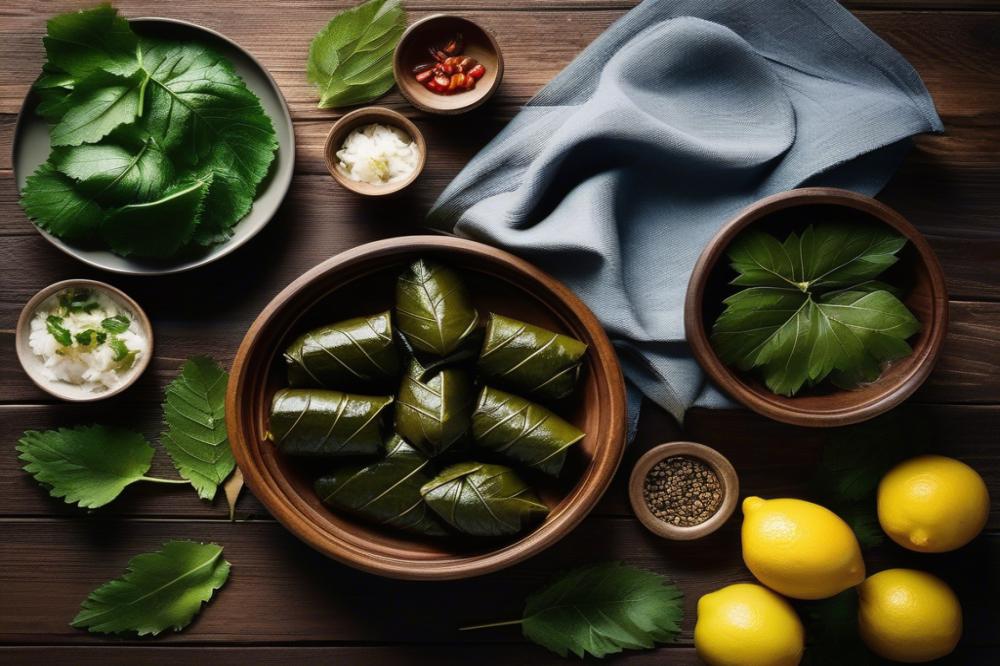
Making dolmades at home can be an enjoyable experience. Follow this step-by-step method for preparing a delicious rice filling wrapped in grape leaves.
First, rinse the rice in cold water and soak it for about half an hour. This helps to soften the grains before cooking. Next, heat olive oil in a pan over medium heat. When it feels hot, throw in finely chopped onions. Sauté them until they become translucent and fragrant.
Once the onions are ready, add the drained rice to the pan. Stir it gently to mix with the onions. At this stage, incorporate any herbs, spices, and nuts of your choice. Dill, mint, and pine nuts work wonderfully in this Mediterranean cuisine dish. They bring flavor and texture to your filling.
After a few minutes of stirring, remove the pan from heat. Squeeze fresh lemon juice over the mixture and add some lemon zest. This will give a bright, fresh flavor to the rice filling. Now, it’s time to prepare the grape leaves.
Rinse the grape leaves under cold water. Lay them flat on a clean surface. Each leaf should be smooth and ready for rolling. Place a spoonful of rice filling in the center of a leaf. Carefully fold the sides over the filling and then roll it up from the stem end. Think of it as making small parcels!
Arrange the rolled dolma snugly in a pot. Once all the grape leaves are filled, cover them with either vegetable broth or water. This liquid will keep the dolmades moist while cooking.
Now, bring the pot to a gentle simmer. Cover it and let it cook for 40 to 50 minutes. The grape leaves will become tender, and the flavors will meld beautifully. When they’re ready, serve the dolmades warm. Drizzle with additional lemon juice or add a side of yogurt for a refreshing touch.
Cultural Significance of Dolmades
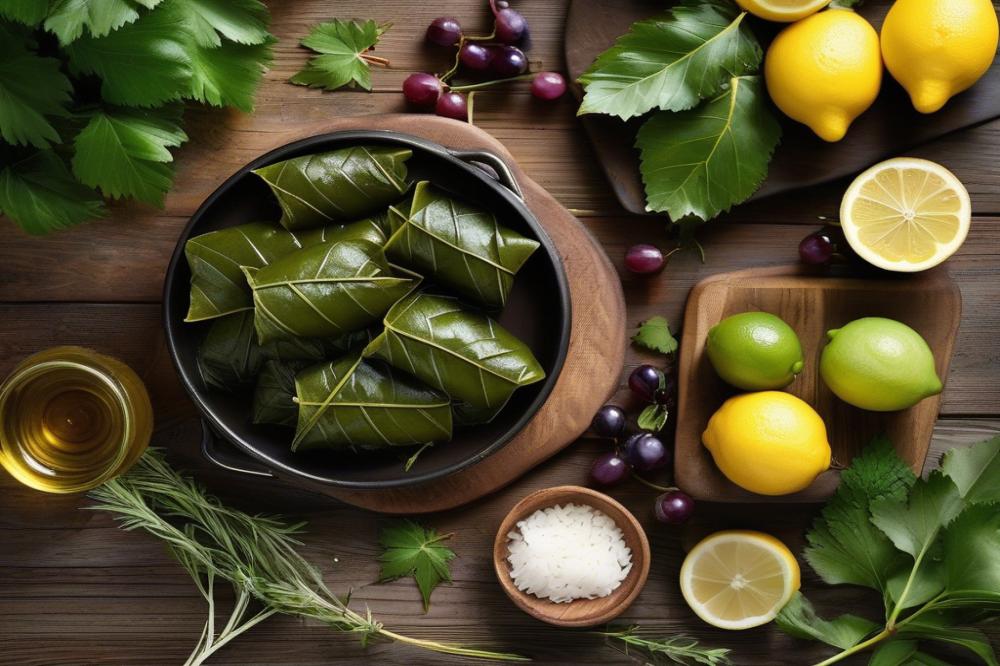
Dolmades are much more than a tasty dish. Historically, they have deep roots in Greek culture and tradition. Families often gather during celebrations, sharing these flavorful treats. Each bite represents a connection to the past and a celebration of togetherness.
In Greece, these stuffed grape leaves showcase the culinary heritage that has been passed down through generations. At festive gatherings, they appear on tables adorned with other classic foods. Their presence signifies joy and hospitality.
Regional variations add to their allure. Different areas may use various fillings like spiced meats or lentils, offering unique tastes. Herbs like dill and mint are often included, enhancing the flavors. This diversity reflects the geography and climate of Greece. Each variant tells a story of local ingredients and traditions.
Olive oil and lemon juice play crucial roles in preparing dolmades. These elements not only enrich the dish but also emphasize the Mediterranean cuisine that thrives on fresh, vibrant ingredients. The rice filling is often coupled with flavorful herbs to create a satisfying vegetarian dish that appeals to many.
Outside Greece, dolmades have gained popularity. They often find their way onto menus in many countries, loved for their unique taste and health benefits. Mediterranean cuisine has embraced this cultural dish, showcasing its versatility.
Recipes for dolma can now be found worldwide, adapted to fit various tastes and dietary preferences. The simplicity of the concept allows for creativity, making it a favorite for many home cooks. It’s clear that this delectable dish has evolved and continues to bring people together.
Tips for Perfect Dolmades
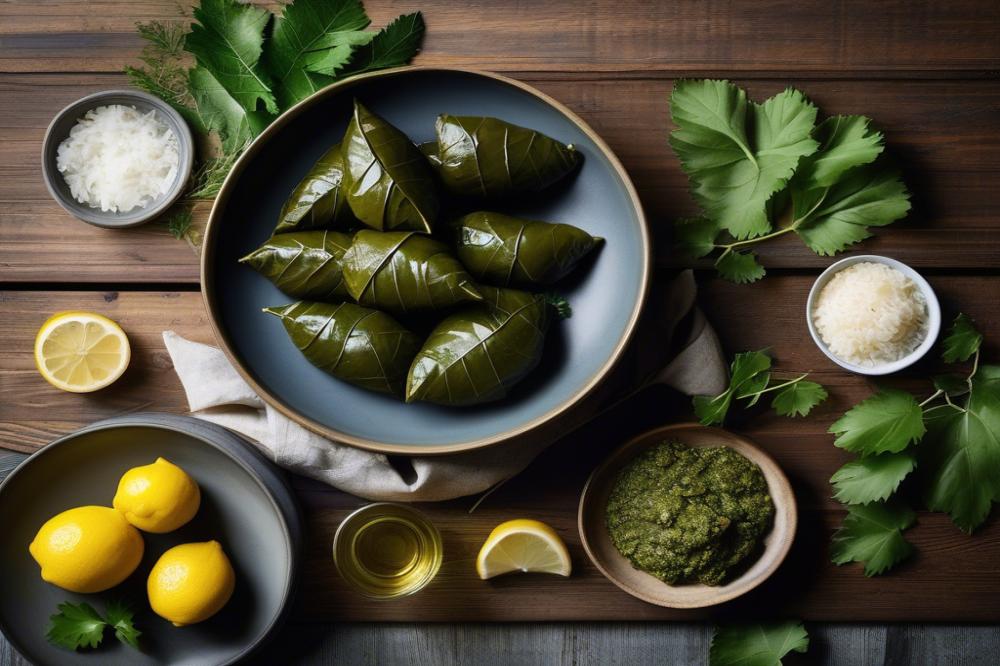
Selecting the best grape leaves is key. Look for young, tender leaves. Fresh leaves shine bright and feel pliable. If using canned ones, choose a respected brand. Always rinse them well to reduce the briny taste.
For the rice filling, start with quality grains. White or brown rice both work, but give a different texture. Add plenty of fresh herbs like dill and parsley for flavor. A hint of mint can elevate the dish, offering a refreshing taste. Don’t forget the olive oil and lemon juice. They enhance the Mediterranean cuisine vibes wonderfully.
Rolling techniques can determine the final look. Place a spoonful of filling at the base of a leaf. Fold up the sides and then roll it tightly like a burrito. Practice makes perfect. If the leaves tear, don’t panic—just use the torn pieces to cover the gaps.
Feel free to experiment with fillings too. Ground meat can be mixed with rice for a heartier option. Alternatively, try a fully vegetarian dish by adding chopped vegetables or beans. Spice levels can be adjusted according to your taste. More herbs can lead to vibrant flavors, while adding spice gives it a kick.
When serving, presentation matters. Arrange them nicely on a platter. Serve with tzatziki for a refreshing dip or a simple yogurt sauce. Pair them with a glass of white wine or a light-bodied red. These drinks complement the dish nicely, enhancing every bite.
Feeling creative? Garnish your dolma with extra lemon wedges or herbs. A drizzle of olive oil right before serving adds richness. This cultural dish offers endless variations, making it special for every meal. Embrace your culinary journey with these stuffed vine leaves for a memorable experience.
Embracing the Joy of Making Dolmades
Crafting dolmades is more than just cooking; it’s a celebration of heritage, flavor, and togetherness. This dish has roots deep in Mediterranean culture, representing community and tradition. The process of rolling grape leaves around a savory rice filling allows you to connect with family and friends in a meaningful way. It encourages shared experiences and memories that bring loved ones closer.
Encouragement comes naturally when imagining a kitchen filled with laughter and chatter as you all join in on the fun of preparing this meal. Try gathering a group, picking the fresh leaves, and preparing the filling together. Such moments will create lasting bonds, as everyone gets involved in this rewarding task.
Don’t hesitate to experiment with different ingredients. Changing spices or adding nuts can transform the taste, allowing you to make the dish truly your own. You can even explore using quinoa or barley for a healthy twist. The possibilities are endless, and your creativity can shine through these variations.
Next time you prepare dolmades, think of the joy it brings. Both the process and the final dish foster connections with Mediterranean cuisine and its rich history. Embrace this culinary journey, and share it with those you care about. Your adventure in cooking will be one filled with flavors, memories, and perhaps a little laughter along the way.

